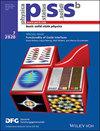Effect of Ferromagnet/Organic Semiconductor Interface Defect States on Tunnel Magnetoresistance of Hybrid Magnetic Tunnel Junctions
IF 1.8
4区 物理与天体物理
Q3 PHYSICS, CONDENSED MATTER
引用次数: 0
Abstract
Herein, analytical modeling of Fe铁磁体/有机半导体界面缺陷态对混合磁性隧道结隧道磁阻的影响
在此,我们使用红宝石、C60 和 BCP 作为有机间隔层,对 Fe3O4/x(≈1.1 nm)/Co(x = rubrene、C60 和 bathocuproine (BCP))磁隧道结 (MTJ) 进行了分析建模。模拟被视为非平衡格林函数,假定铁磁体/有机半导体(FM/OSC)界面缺陷态的自旋前驱。据观察,平行(RP)和反平行(RAP)取向的电压相关电阻取决于 FM/OSC 缺陷态的自旋注入。与引脚相关的缺陷态深度与器件 FM/OSC 界面的带错配引起的晶格畸变有关。基于红宝石的 MTJ 器件的隧道磁阻(TMR)响应较大,这是因为 FM/OSC 缺陷态深度随电压的变化较大。高 TMR 可能会减少依赖于自旋转矩的自旋前驱,从而降低红柱石器件的自旋传递转矩。因此,对 FM/OSC 界面的缺陷态进行工程设计可能会成功实现有机间隔 MTJ 的增强 TMR,从而实现高性能的自旋电子存储器应用。
本文章由计算机程序翻译,如有差异,请以英文原文为准。
求助全文
约1分钟内获得全文
求助全文
来源期刊
CiteScore
3.30
自引率
6.20%
发文量
321
审稿时长
2 months
期刊介绍:
physica status solidi is devoted to the thorough peer review and the rapid publication of new and important results in all fields of solid state and materials physics, from basic science to applications and devices. Being among the largest and most important international publications, the pss journals publish review articles, letters and original work as well as special issues and conference contributions.
physica status solidi b – basic solid state physics is devoted to topics such as theoretical and experimental investigations of the atomistic and electronic structure of solids in general, phase transitions, electronic and optical properties of low-dimensional, nano-scale, strongly correlated, or disordered systems, superconductivity, magnetism, ferroelectricity etc.

 求助内容:
求助内容: 应助结果提醒方式:
应助结果提醒方式:


